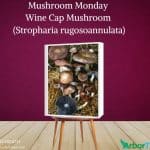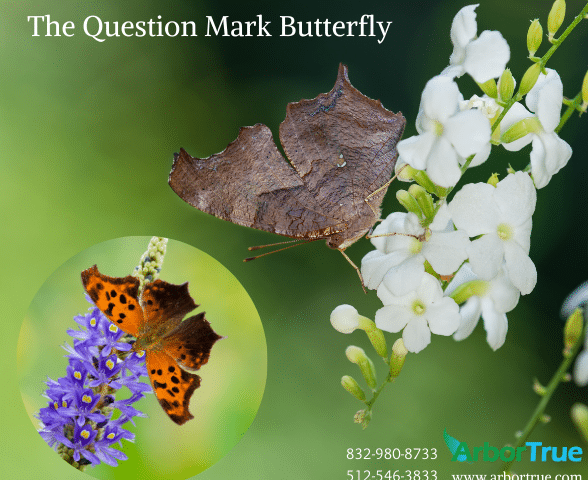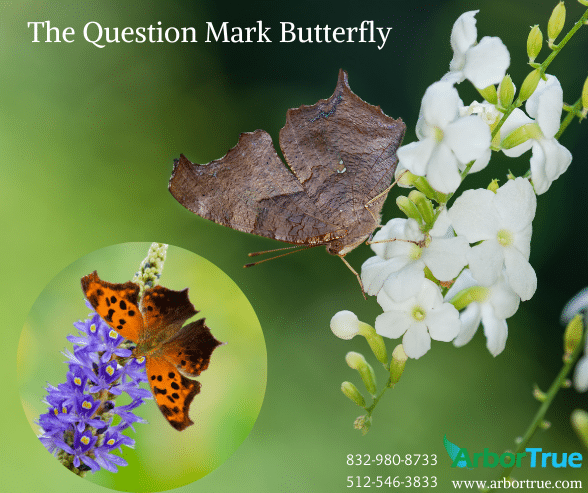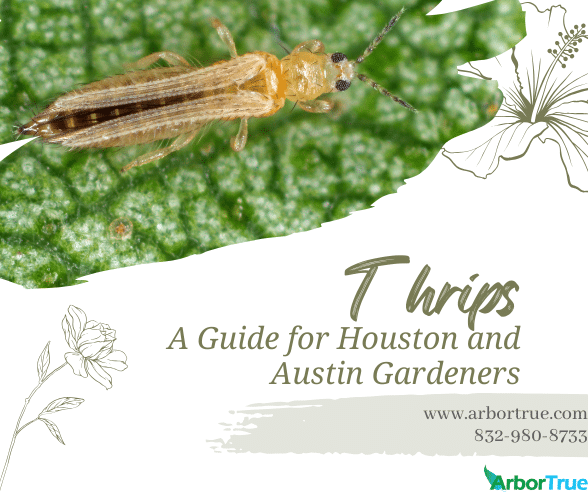
Mushroom Monday: Wine Cap Mushroom (Stropharia rugosoannulata)
June 3, 2024
Mourning Cloak Butterflies
June 7, 2024
The Question Mark Butterfly
We recently posted about two common trees in Austin, the Cedar Elm and the Sugarberry. In those posts we mentioned two butterflies, the question mark butterfly and the mourning cloak butterfly. We thought we’d spend a couple of posts highlighting these two butterflies you might see in the Austin, Texas area. In today’s post we look at the question mark butterfly.
Their Scientific and Common Names
The scientific name of question mark butterflies is Polygonia interrogationis. The Polygonia part refers to the angles of their wings. Think of a polygon as something with many sides. Polygonia refers to the many angles. The interrogationis part of their name refers to the question mark pattern they have on their wings (this is what gives them their common name). The word sounds like the English word interrogate, which involves questions.
What are the Life Stages of Question Mark Butterflies?
Like other butterflies, question mark butterflies go through four life stages. They start out as eggs, then become larva (caterpillars), then pupa (chrysalis), and then adults (butterflies).
What do Question Mark Butterfly Eggs Look Like?
Their eggs are green and have ridges on them. They sort of resemble very tiny melons. They can be laid individually, stacked on top of each other, or in groups. The eggs are laid on the bottom sides of leaves. They can be laid on host plants (those the larvae eat) or on nearby plants (more commonly).
What do Question Mark Butterfly Caterpillars Look Like?
In the larvae stage, question mark butterflies can have a striking appearance.
They can grow to be a little less than one and half inches in length. They have a head that is brown/red and that has spines on it. Their bodies are mostly black, with lines and spots that can be yellow or white. Some have so many lines and spots that it can be hard to see the black coloring underneath.
On their backs they have spines. The spines can be different colors including black, orange, yellow, or red, and can have a combination of colors on them.
As caterpillars, they don’t live in groups.
What do Question Mark Butterflies Look Like as Pupae?
In their pupae stage (called a chrysalis) they are in between being a caterpillar and a butterfly. This is the stage of transition, when they undergo metamorphosis. In this stage they hang from a plant and look like a dead folded leaf. In this stage they can be brown or tan in color with white spots on their top edge.
What do Question Mark Butterfly Adults Look Like?
There are different ways to describe the appearance of question mark butterflies. Their appearances differ between whether they are summer or winter butterflies and the topsides of their wings look different than the bottom sides.
The summer and winter generations are very similar. The difference is in the coloration of the topside of their wings. The summer generation butterflies have a black coloration on the topsides of their rear wings and the winter generations have an orange coloration (both have two front wings and two rear wings). They have two tails, with those of the winter generation being greater in length than those of the summer generation. There are some other differences, but apart from these main ones, they generally look the same.
Their wings have scalloped edges and can get to be around two to two and a half inches across. They have long antennae and their front legs look like a brush and they hold them close to their bodies.
As for the topsides of their wings, they can have a white coloration around the edges. The topsides of their wings are orange and black in color with dark brown markings. They look similar to the eastern comma butterfly (Polygonia comma). Both butterflies have three dots in a row on each of their upper wings, but the question mark butterfly also has a dash at the end of the dots.
The bottom sides of their wings (what you would see if their wings were closed) look very similar to a dead leaf and they can be well camouflaged. The bottom of their wings have various colors including brown, light brown, gray, blue, silver, and white. The name “question mark” comes from a pattern on the middle of their back wings that looks like a question mark. It can be silver in color. Sometimes the period part of the question mark can be smaller or not there.
Where can Question Mark Butterflies be Found?
Question mark butterflies can be found in a number of places in the U.S. generally from the center part of the country to the east. They can also be found in southern Canada, as well as in Mexico. They can be found in woods with open areas as well as suburban areas as well as parks and prefer moist places.
What do Question Mark Butterflies Eat?
As larvae (caterpillars) they eat leaves of host plants. Host plants include elms, such as American elms, sugarberry trees, and stinging nettles.
As adults they eat things that might seem unusual for a butterfly. They eat fruit that’s fermenting, sap from trees, dung, dead animals, and in some cases flowers. If they eat fruit that’s fermenting they can appear intoxicated. Flowers may be a food source when other things aren’t available.
What Eats Question Mark Butterflies?
Things that generally eat caterpillars and butterflies, such as birds, are predators of question mark butterflies. They are also preyed upon by certain parasitoids.
If you found learning about question mark butterflies interesting, be sure and check out our other TrueTreeTalk blog posts. Be sure and check out our upcoming post about mourning cloak butterflies as well. Follow us on Facebook to keep up with these and other posts.
* * *
ArborTrue is a science-based tree-service company. We provide a range of services including tree trimming, tree pruning, tree removal, tree planting, arborist consultations, and more. Reach out to us online to schedule an appointment.




